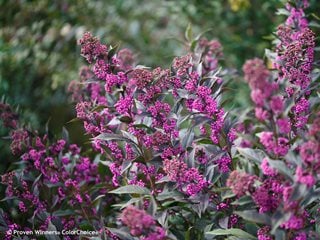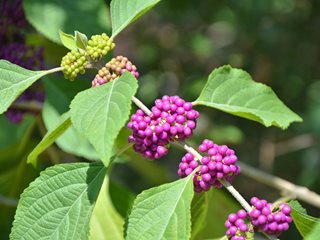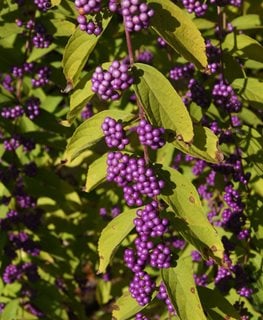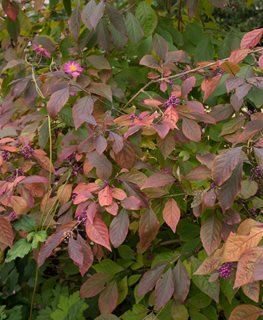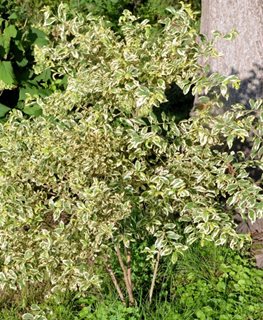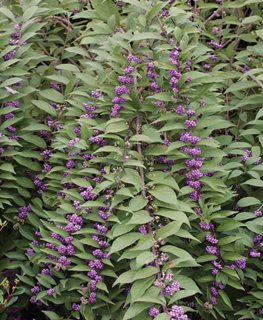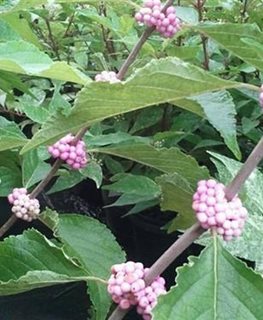Beautyberry Brings Bold Color to the Fall Garden
Callicarpa steals the show with vibrant purple berriesA plant with the audacity to bear the name beautyberry better deliver on the promise—and beautyberry doesn’t disappoint. Starting out in spring as a rather unassuming shrub, it begins to earn its praises in late summer, when other plants are fading. Abundant clusters of fruit ripen into striking purple berries that stand out boldly against the warmer color tones typical of the season. Those colorful berries persist well after the leaves fall, decorating the bare branches like shiny purple jewels.
For gardeners looking for a more subdued ornamental shrub for the fall garden, there are also lovely beautyberry cultivars with white or light pink fruit. No matter your preference, few fruit-bearing shrubs can compete with beautyberries when they are at their peak of color. The sight of those glossy berries strung along the shrub’s graceful arching branches are one of the most unexpected pleasures of the season.
On this page: Basics | Types | Growing Guide | Care and Maintenance | Beautyberry Pictures | Garden Uses
- BEAUTYBERRY BASICS
- TYPES OF BEAUTYBERRY
- GROWING GUIDE
- CARE AND MAINTENANCE
- BEAUTYBERRY PICTURES
- GARDEN USES
THE BASICS
Botanical name:
Callicarpa, derived from a combination of the Greek words callos (beautiful) and carpos (fruit).
Plant Type:
Deciduous shrub
Hardiness:
Varies depending on the species, ranging Zones 5 to 9
Height:
3 to 8 feet
Bloom time:
Beautyberries flower in clusters at almost every leaf node in late spring to midsummer. Although attractive, the tiny pink or white flowers often go unnoticed because they are obscured by the foliage.
Fruit duration:
The berries (which are actually drupes, or one-seeded fruits) begin maturing in late August and remain on the plant up to six weeks or longer after the leaves fall.
Is the fruit edible?
Yes, the berries are nontoxic to animals as well as humans. They are also on the menu of more than 40 species of songbirds. Despite being edible, beautyberries aren’t very palatable when eaten raw because they tend to be bitter. However, they can be cooked and sweetened to make jellies or sauces.
TYPES OF BEAUTYBERRY
There are approximately 140 species, but four in particular—one native to southeastern North America and three of Asian origin—are commonly used as ornamental garden shrubs.
American beautyberry: Callicarpa americana is one of the showiest beautyberries because of its especially large magenta-purple berries that wrap tightly around the branch like beaded bracelets. This is also the largest of the beautyberries, reaching 6 to 8 feet tall with an equal spread. Native to the Southeast—from Maryland to Florida and west through Texas—it grows best in climates with mild winters and hot, humid summers (Zones 6-10).
Asian beautyberry: The three Asian species, Callicarpa japonica from Japan, Callicarpa bodinieri from China, and Callicarpa dichotoma, from Japan, China, and Korea, are more cold tolerant (Zones 5-8) than their American cousin. Other distinguishing features include a more arching or weeping form and smaller berries that hang from the branches in grape-like bunches. Of the three, C. dichotoma is the smallest, reaching only 3 to 4 feet with a similar spread.
Note: C. dichotoma has been declared invasive in the South and eastern U.S. Learn more about where this plant is invasive.
All of these species have a number of white- and purple-fruited cultivars. But if you’re looking for something unique, try C. americana 'Welch's Pink' (a pink-fruited variety), C. dichotoma ‘Duet’ (white berries and variegated foliage), and Pearl Glam®, a newer hybrid with dark purple leaves.
GROWING GUIDE
Soil:
Beautyberries prefer moist soil rich in organic matter. They aren’t particular about soil type, but good drainage is a must.
Light requirements:
Grow in full sun or light shade; but for optimum berry production, a sunny location is best.
When to plant:
Spring or fall.
Spacing:
When planting beautyberry, give it plenty of room to sprawl. The weight of the berries often cause the shrub’s flexible branches to bend, which can shade or crowd nearby plantings. As a general rule of thumb, space plants about 5 to 7 feet apart.
Propagation:
Beautyberry readily self-sows in the garden but can also be propagated from softwood cuttings. Although beautyberry is self-pollinating, some species (such as C. americana) have a better chance for cross-pollination when planted in groupings, which may result in higher fruit yields.
Is beautyberry invasive:
As mentioned, beautyberry will readily self-sow. Check with local experts to see if this poses a threat where you live, or learn more about where beautyberry may be considered invasive.
CARE AND MAINTENANCE
Water requirements:
Although established beautyberries can tolerate some drought, under extreme conditions they may drop their leaves and berries to compensate for the lack of moisture. For the best performance, be sure to maintain consistent soil moisture, giving your shrubs about an inch of water per week during prolonged dry spells.
Fertilizing:
Don’t bother. Applying too much fertilizer, especially types that are high in nitrogen, will promote foliage growth but at the expense of fewer flowers and berries.
Pruning:
Although beautyberry shrubs don’t have to be pruned to produce fruit year after year, you’ll get a more robust berry display by cutting them back in late winter or early spring while they are still dormant. Because beautyberry blooms on new wood, a hard pruning to just several inches above the ground won’t affect flower production and will keep plants looking dense and full.
Problems:
Once established, beautyberry requires very little maintenance, except for occasional pruning. They resist most foliar diseases and pests. In colder growing zones, your plants may experience some dieback in winter, but they will often resprout from the ground in spring and produce fruit that same year.
BEAUTYBERRY PICTURES
GARDEN USES
Beautyberries make good choices for:
- Wildlife gardens
- Screening
- Natural hedges
- Focal points for fall interest
- Cottage gardens
- Japanese gardens
RELATED:
Shrubs 101
Shrubs for Shade
10 Ways to Start Building a Garden for Wildlife
17 Fast-Growing Shrubs for Your Garden
Berries for Year-Round Color
15 Best Shrubs for Privacy
